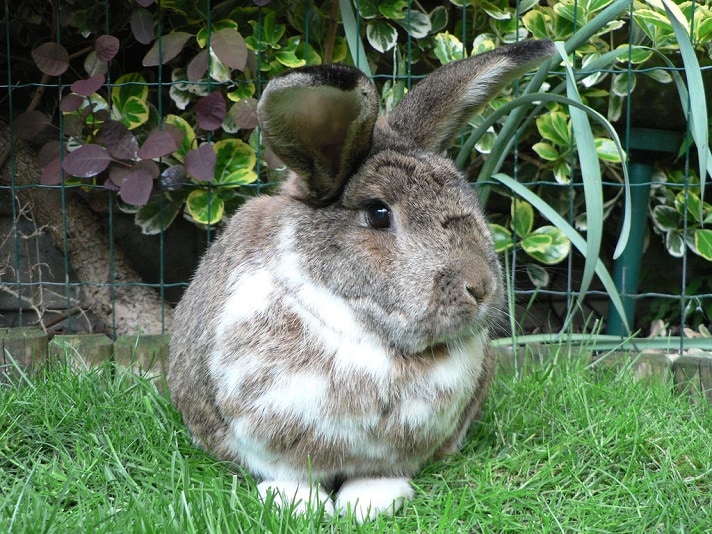If you’ve not yet heard of it, encephalitozoon cuniculi, called E. cuniculi (EC), is a tiny parasite that lives inside infected rabbits, is a notable cause of diseases and can be passed to humans, especially those already susceptible to illness. It is a microsporidian, a type of organism more closely related to fungi than to protozoans or animals.
Unfortunately, almost all pet rabbits have been exposed to the organism at some point. The infection is passed on through spores shed in an infected mammal’s urine, and even if you practice good hygiene, there’s a chance your rabbit still might contract EC. They can acquire the disease from ingesting the spores, inhaling the spores or having the spores settle on their eyes. Also, infected does can pass EC on to their unborn babies.
If you rabbit is ill, E. cuniculi is a disease that you and your veterinarian must consider, and EC screening should be part of any pet rabbit’s wellness program. If your rabbit develops signs of EC, early treatment is more likely to help than care started even several days after the first signs of illness.
Treating E. Cuniculi in Rabbits
Unfortunately, no specific medications target microsporidians. Developing such a medication was not a priority for pharmaceutical companies until human patients with AIDS started to develop infections by unusual organisms, and then some cases of microsporidiosis were found in seemingly healthy humans.
Albendazole, fenbendazole and oxfendazole medications are used to treat nematodes and other parasitic worms, and they happen to offer some efficacy against EC. Though it is the drug of choice in people, Albendazole has a negative reputation in the pet rabbit community.
While Albendazole does have adverse side effects, no peer-reviewed studies have proven that the alternatives, fenbendazole and oxfendazole, do not have similar side effects in EC-infected rabbits. The only peer-reviewed treatment study on E. cuniculi in rabbits used fenbendazole, and, despite the flaws in this study, it has been the standard for deriving treatments for EC-positive rabbits. This, combined with the drug’s availability, affordability, shelf-life and acceptability to most clients over albendazole, is why I routinely prescribe fenbendazole for EC rabbits.
Due to the nature of the EC lesions, some vets give corticosteroids to EC rabbits to reduce the brain inflammation. The risk with this treatment is that corticosteroids might suppress the immune system to the point that EC or other infectious organisms may create additional problems.
For that reason, some veterinarians choose to go with nonsteroidal anti-inflammatory drugs (NSAIDS), such as meloxicam. Corticosteroids such as prednisone or dexamethasone seem to be more effective than meloxicam, but it might be that the meloxicam dose advised for rabbits does not provide adequate blood levels.
No study has definitively answered how much meloxicam a rabbit should receive to control inflammation or what dose of corticosteroid is best. Never give a rabbit a corticosteroid with meloxicam, as this can cause stomach ulcers!
Some vets give EC rabbits doxycycline, an antibiotic with some anti-inflammatory properties, along with corticosteroids or meloxicam. Red palm oil and other balanced omega fatty acid mixtures may help reducing inflammation. I’ve used Booster, a proprietary product from Harrison’s Pet Products that contains red palm oil and a substance with antibiotic properties, with EC-infected rabbits, but it is difficult to evaluate its overall impact given the other medications given in the course of treatment.
Ponazuril, a medication effective against coccidia, and ivermectin, a medication effective against nematodes and other invertebrate parasites, are given by some veterinarians. As well, Lufenuron, a flea treatment formulated to inhibit chitin production, has been tried on the assumption that one part of the microsporidian life cycle, the endospore, has chitin.
A combination treatment of pyrimethamine, sulfadiazine, folic acid and meloxicam has been tried on E. cuniculi in rabbits extrapolating from work done on horses with certain parasites. Enrofloxacin and chloramphenicol, both antibiotics, sometimes are given as well.
Many other medications have been tried, but it is unclear if any of these treatments include anti-microsporidian properties because no peer-reviewed, controlled studies or peer-reviewed, retrospective studies have been done to assess the validity of the claims that are made. Furthermore, all of these medications are extra-label use in rabbits.
Nursing Care of EC Rabbits
Nursing care for rabbits with EC includes assistance feeding your pet with a liquid diet, providing subcutaneous fluids if she cannot stay well-hydrated and applying eye lubrications. If your rabbit is unable to clean her rump area from night feces and other debris, doing it for her helps prevent scalding.
Meclizine or other anti-nausea/anti-vertigo medications may help improve a rolling rabbit’s attitude and appetite. A soft, cushioned environment, like a large plastic tub lined with towels or soft cushions, is needed for rolling rabbits. And a rabbit with a head tilt will benefit from massage to help relieve the stress of the abnormal muscle posture.
It can take weeks for a rabbit to show significant improvement. Many end up with a permanent head tilt but otherwise seem to enjoy a normal quality of life.
Rabbits with cataracts can undergo surgery to remove the problem lens. This surgery is costly, and not every veterinary ophthalmologist is willing to work on rabbits. However, if the infected lens is left in place it might rupture and cause further inflammation in the eye, even with prophylactic drug therapy that includes fenbendazole.
Preventing E. Cuniculi Infection
There is no vaccine to prevent E. cuniculi in rabbits, and EC spores stay alive for months under the right conditions. Fortunately, chlorine bleach and other readily available disinfectants kill the spores.
To combat EC spores, follow these steps.
- Thoroughly clean your rabbit’s environment to remove obvious urine, feces and other organic dirt, such as pellets and hay.
- Wash her cage, food bowls and other furnishings in hot, soapy water to remove the invisible dirt. Rinse all these items in hot water.
- Disinfect the clean items by applying a diluted solution of bleach (1:32) to each one. Let them sit for 15-30 minutes before rinsing them again in fresh hot water.
- Wash all towels or cloth items in hot, soapy water and bleach. To avoid fading your cloth items, use a commercial disinfectant such as Roccal. Vinegar often is touted as a safe disinfectant, but it may not kill EC spores.
EC spores can be anywhere your rabbit was, such as the couch, carpet or bed, and the spores can float around in the air and reach other places, too. If you have an EC-positive rabbit, consider your whole household contaminated.
This means is that any rabbit coming into your household is being exposed to the EC spores, and any visitors who live with rabbits might pick up spores and bring them back to their own pets. You needn’t be considered a pariah, though, because almost every pet rabbit has been exposed to EC at some point in her life and either successfully fought the infection so she is not ill or already contracted the infection and has shown signs of illness.
Controversy exists about how to manage EC-positive rabbits. I recommend that any EC-positive rabbit, whether or not she shows signs of illness, is treated monthly with a 3- to 5-day course of fenbendazole. Other rabbits in the household can get monthly doses.
Put any new rabbits entering your household on the same monthly dose. Also, any time a rabbit undergoes stress, such as travel, boarding or other unusual activity, I put her on prophylactic fenbendazole.
A coordinated effort to provide major funding for EC research of pet rabbits is needed if we are to make any advances in its prevention and treatment.
By: Kevin Wright, DVM, DABVP
Featured Image: Via iStock.com/Merrimon
Share:









